Computational Mechanics for Turbofan Engine Blade Containment Testing: Fan Case Design and Blade Impact Dynamics by Finite Element Simulations
Abstract
:1. Introduction
2. Materials and Methods
2.1. Characteristic Properties of the Ti64 Titanium Alloy
2.2. Johnson–Cook Plasticity and Damage Prediction Model for Ti64
2.2.1. Johnson–Cook Plasticity Model
2.2.2. Johnson–Cook Damage Model
2.3. Finite Element Simulation of Containment Test
2.3.1. Turbofan Model and Boundary Conditions
2.3.2. Meshing of the Turbofan Model
2.3.3. Structural Integrity Assessment and Casing Design Adaptation
3. Results and Discussion
3.1. Qualitative Model Assessment with Real Containment Test Impact Dynamics
3.2. Comparison of Simulation Results with Two Sets of Parameters of the Johnson–Cook Law of Plasticity and Damage
3.3. Turbofan Casing Redesign
3.4. Limitations and Future Research Directions
4. Conclusions
- A significant difference was found between the equivalent stress and equivalent plastic strain results obtained through simulation with the parameters identified in this work and the parameters reported by P. Verleysen and J. Peirs, 2017 [43].
- The results demonstrate that there is no single set of parameters for the same material. They will depend on the reference strain rate and the range of strain rates and/or temperatures used in the identification. However, the validity of the parameters is mainly based on the ability of the fitted model to predict the initial yield stress at high speeds. In the case of the Ti64 alloy studied, it is above 1200 MPa, which is correctly modeled by the results provided in the simulations with the data identified in the work of Tuninetti et al. in 2024 [35].
- The model developed for the simulation is realistic since it presents the same impact dynamics observed in a real blade containment test. This qualitatively validates the model generated for the design purpose of a new aircraft engine that meets the structural conditions required for a safe, damage-tolerant design.
- The simulations with thickness variation and consequent adaptation of the casing topology allowed us to find a damage-tolerant turbofan model, absorbing the kinetic energy of the blade during the impact and transforming it into plastic deformation work energy without fracture. The proposed design process allows the thickness of the turbofan casing to be optimized until a lightweight and safe structural design is achieved.
Author Contributions
Funding
Data Availability Statement
Conflicts of Interest
References
- Nasr, M.; Moffat, T. A Design Methodology for Fan Blade-off Based on Structural Failure. In Proceedings of the 19 Conference ISABE, Montreal, QC, Canada, 11–13 November 2009; pp. 1–6. [Google Scholar]
- Yang, B. Blade containment evaluation of civil aircraft engines. Chin. J. Aeronaut. 2013, 26, 9–16. [Google Scholar] [CrossRef]
- He, Z.; Xuan, H.; Bai, C.; Song, M.; Zhu, Z. Containment of soft wall casing wrapped with Kevlar fabric. Chin. J. Aeronaut. 2019, 32, 954–966. [Google Scholar] [CrossRef]
- Valenzuela, M.; Leiva, J.; Salas, A.; Ciudad, G.; Cárdenas, J.P.; Oñate, A.; Hunter, R.; Attia, S.; Tuninetti, V. CEBs with GRC: Fabrication, characterization, modeling, and correlation with microstructural fracture features. Mater. Today Commun. 2023, 37, 107028. [Google Scholar] [CrossRef]
- Rojas-Ulloa, C.; Morch, H.; Tuninetti, V.; Duchêne, L.; Habraken, A.M. Implementation of a modified Graham-Walles viscosity function within a Chaboche viscoplastic constitutive model. Comput. Math. Appl. 2024, 155, 165–175. [Google Scholar] [CrossRef]
- Valdivia, I.; Canales, C.; Tuninetti, V.; Flores, P.; Medina, C. Numerical Prediction of Failure in Unidirectional Fiber Reinforced Composite. Int. J. Appl. Mech. 2021, 13, 2150073. [Google Scholar] [CrossRef]
- Bustos, F.; Hinojosa, J.; Tuninetti, V. Computational Comparison of Performance of Different Steel Plate Shear Yielding Dampers. Buildings 2023, 13, 793. [Google Scholar] [CrossRef]
- Tuninetti, V.; Habraken, A. Impact of anisotropy and viscosity to model the mechanical behavior of Ti–6Al–4V alloy. Mater. Sci. Eng. A 2014, 605, 39–50. [Google Scholar] [CrossRef]
- Saavedra Flores, E.I.; Murugan, M.S.; Friswell, M.; De Souza Neto, E.A. Multi-scale constitutive model for a wood-inspired composite. Procedia Eng. 2011, 10, 3616–3621. [Google Scholar] [CrossRef]
- Guzmán, C.F.; Saavedra Flores, E.I.; Habraken, A.M. Damage characterization in a ferritic steel sheet: Experimental tests, parameter identification and numerical modeling. Int. J. Solids Struct. 2018, 155, 109–122. [Google Scholar] [CrossRef]
- Ahmad, D.; Kumar, D.; Ajaj, R.M. Multiaxial Deformations of Elastomeric Skins for Morphing Wing Applications: Theoretical Modeling and Experimental Investigations. Polymers 2022, 14, 4891. [Google Scholar] [CrossRef]
- Ahmad, D.; Ajaj, R.M. A Multiaxial Fracture of Ecoflex Skin with Different Shore Hardness for Morphing Wing Application. Polymers 2023, 15, 1526. [Google Scholar] [CrossRef] [PubMed]
- Castillo, J.I.; Celentano, D.J.; Cruchaga, M.A.; García-Herrera, C.M. Characterization of strain rate effects in sheet laser forming. Comptes Rendus Mec. 2018, 346, 794–805. [Google Scholar] [CrossRef]
- Morch, H.; Duchêne, L.; Harzallah, R.; Tuninetti, V.; Habraken, A.M. Efficient temperature dependence of parameters for thermo-mechanical finite element modeling of alloy 230. Eur. J. Mech.—A/Solids 2021, 85, 104116. [Google Scholar] [CrossRef]
- Valenzuela, M.; Ciudad, G.; Cárdenas, J.P.; Medina, C.; Salas, A.; Oñate, A.; Pincheira, G.; Attia, S.; Tuninetti, V. Towards the development of performance-efficient compressed earth blocks from industrial and agro-industrial by-products. Renew. Sustain. Energy Rev. 2024, 194, 114323. [Google Scholar] [CrossRef]
- Beltrán, F. Teoría General del Método de los Elementos Finitos; Universidad Politécnica de Madrid: Madrid, Spain, 1998; Available online: https://www.researchgate.net/publication/263926691 (accessed on 15 April 2024).
- Sinha, S.K.; Dorbala, S. Dynamic Loads in the Fan Containment Structure of a Turbofan Engine. J. Aerosp. Eng. 2008, 323, 1–14. [Google Scholar] [CrossRef]
- Sinha, S.K. Rotordynamic analysis of asymmetric turbofan rotor due to fan blade-loss event with contact-impact rub loads. J. Sound Vib. 2013, 332, 2253–2283. [Google Scholar] [CrossRef]
- He, Q.; Xuan, H.; Liu, L.; Hong, W.; Wu, R. Perforation of aero-engine fan casing by a single rotating blade. Aerosp. Sci. Technol. 2013, 25, 234–241. [Google Scholar] [CrossRef]
- Man, M.H.C.; Liu, H.; Low, K.H. Severity assessment of aircraft engine fan blades under airborne collision of unmanned aerial vehicles comparable to bird strike certification standards. Proc. Inst. Mech. Eng. Part G J. Aerosp. Eng. 2022, 236, 1817–1835. [Google Scholar] [CrossRef]
- Johnson, G.R.; Cook, W.H. A constitutive model and data for metals subjected to large strains, high strain rates and high temperatures. In Proceedings of the 7th International Symposium on Ballistics, The Hague, The Netherlands, 19–21 April 1983; pp. 541–547. [Google Scholar]
- Mirzaie, T.; Mirzadeh, H.; Cabrera, J.-M. A simple Zerilli–Armstrong constitutive equation for modeling and prediction of hot deformation flow stress of steels. Mech. Mater. 2016, 94, 38–45. [Google Scholar] [CrossRef]
- Huang, S.; Khan, A. Modeling the mechanical behaviour of 1100-0 aluminum at different strain rates by the bodner-partom model. Int. J. Plast. 1992, 8, 501–517. [Google Scholar] [CrossRef]
- Fameso, F.; Desai, D.; Kok, S.; Newby, M.; Glaser, D. Simulation of laser shock peening on X12Cr steel using an alternate computational mechanical threshold stress plasticity model. Int. J. Adv. Manuf. Technol. 2020, 111, 1–11. [Google Scholar] [CrossRef]
- Nemat-Nasser, S.; Guo, W.-G. Thermomechanical response of HSLA-65 steel plates: Experiments and modeling. Mech. Mater. 2005, 37, 379–405. [Google Scholar] [CrossRef]
- Kotkunde, N.; Deole, A.D.; Gupta, A.K.; Singh, S.K. Comparative study of constitutive modeling for Ti–6Al–4V alloy at low strain rates and elevated temperatures. Mater. Des. 2014, 55, 999–1005. [Google Scholar] [CrossRef]
- Wang, X.; Shi, J. Validation of Johnson-Cook plasticity and damage model using impact experiment. Int. J. Impact Eng. 2013, 60, 67–75. [Google Scholar] [CrossRef]
- Tuninetti, V.; Jaramillo, A.F.; Riu, G.; Rojas-Ulloa, C.; Znaidi, A.; Medina, C.; Mateo, A.M.; Roa, J.J. Experimental Correlation of Mechanical Properties of the Ti-6Al-4V Alloy at Different Length Scales. Metals 2021, 11, 104. [Google Scholar] [CrossRef]
- Rojas-Ulloa, C.; Bouffioux, C.; Jaramillo, A.F.; García-Herrera, C.M.; Hussain, T.; Duchêne, L.; Riu, G.; Roa, J.J.; Flores, P.; Habraken, A.M.; et al. Nanomechanical Characterization of the Deformation Response of Orthotropic Ti–6Al–4V. Adv. Eng. Mater. 2021, 23, 2001341. [Google Scholar] [CrossRef]
- Sima, M.; Özel, T. Modified material constitutive models for serrated chip formation simulations and experimental validation in machining of titanium alloy Ti–6Al–4V. Int. J. Mach. Tools Manuf. 2010, 50, 943–960. [Google Scholar] [CrossRef]
- Tuninetti, V.; Gilles, G.; Flores, P.; Pincheira, G.; Duchêne, L.; Habraken, A.-M. Impact of distortional hardening and the strength differential effect on the prediction of large deformation behavior of the Ti6Al4V alloy. Meccanica 2019, 54, 1823–1840. [Google Scholar] [CrossRef]
- Peirs, J.; Verleysen, P.; Van Paepegem, W.; Degrieck, J. Determining the stress–strain behaviour at large strains from high strain rate tensile and shear experiments. Int. J. Impact Eng. 2011, 38, 406–415. [Google Scholar] [CrossRef]
- Tuninetti, V.; Flores, P.; Valenzuela, M.; Pincheira, G.; Medina, C.; Duchêne, L.; Habraken, A.-M. Experimental characterization of the compressive mechanical behaviour of Ti6Al4V alloy at constant strain rates over the full elastoplastic range. Int. J. Mater. Form. 2020, 13, 709–724. [Google Scholar] [CrossRef]
- Tuninetti, V.; Forcael, D.; Valenzuela, M.; Martínez, A.; Ávila, A.; Medina, C.; Pincheira, G.; Salas, A.; Oñate, A.; Duchêne, L. Assessing Feed-Forward Backpropagation Artificial Neural Networks for Strain-Rate-Sensitive Mechanical Modeling. Materials 2024, 17, 317. [Google Scholar] [CrossRef] [PubMed]
- Tuninetti, V.; Sepúlveda, H.; Beecher, C.; Rojas-Ulloa, C.; Oñate, A.; Medina, C.; Valenzuela, M. A Combined Experimental and Numerical Calibration Approach for Modeling the Performance of Aerospace-Grade Titanium Alloy Products. Aerospace 2024, 11, 285. [Google Scholar] [CrossRef]
- Tuninetti, V. Experimental and Numerical Study of the Quasi-Static Behavior of Ti–6Al–4v. Ph.D. Thesis, Univertisé de Liège, Liège, Belgium, 2014. [Google Scholar]
- Peirs, J. Experimental Charcterisation and Modelling of the Dynamic Behaviour of the Titanium Alloy Ti6Al4V. Ph.D. Thesis, Ghent University, Ghent, Belgium, 2012. [Google Scholar]
- Lecarme, L. Viscoplasticity, Damage, and Fracture of Ti-6Al-4V. Ph.D. Thesis, Université catholique de Louvain, Ottignies-Louvain-la-Neuve, Belgium, 2013. [Google Scholar]
- Tao, Z.-J.; Fan, X.-G.; Yang, H.; Ma, J.; Li, H. A modified Johnson–Cook model for NC warm bending of large diameter thin-walled Ti–6Al–4V tube in wide ranges of strain rates and temperatures. Trans. Nonferrous Met. Soc. China 2018, 28, 298–308. [Google Scholar] [CrossRef]
- Gao, S.; Sang, Y.; Li, Q.; Sun, Y.; Wu, Y.; Wang, H. Constitutive modeling and microstructure research on the deformation mechanism of Ti-6Al-4V alloy under hot forming condition. J. Alloys Compd. 2022, 892, 162128. [Google Scholar] [CrossRef]
- Farahani, H.K.; Ketabchi, M.; Zangeneh, S. Determination of Johnson–Cook Plasticity Model Parameters for Inconel718. J. Mater. Eng. Perform. 2017, 26, 5284–5293. [Google Scholar] [CrossRef]
- Johnson, G.R.; Cook, W.H. Fracture characteristics of three metals subjected to various strains, strain rates, temperatures and pressures. Eng. Fract. Mech. 1985, 21, 31–48. [Google Scholar] [CrossRef]
- Verleysen, P.; Peirs, J. Quasi-static and high strain rate fracture behaviour of Ti6Al4V. Int. J. Impact Eng. 2017, 108, 370–388. [Google Scholar] [CrossRef]
- Kay, G.J. Failure Modelling of Titanium 6Al-4V and Aluminum 2024-T3 with the Johnson-Cook Material Model, US Natl. Tech. Inf. Serv. Springfield, Virginia 22161. DOT/FAA/AR (2003) 1–24. Available online: https://www.tc.faa.gov/its/worldpac/techrpt/ar03-57.pdf (accessed on 15 April 2024).
- Zhang, T.; Chen, W.; Guan, Y.; Gao, D. Study on Titanium Alloy TC4 Ballistic Penetration Resistance Part I: Ballistic Impact Tests. Chin. J. Aeronaut. 2012, 25, 388–395. [Google Scholar] [CrossRef]
- Wang, C.; Zhang, D.; Ma, Y.; Liang, Z.; Hong, J. Dynamic behavior of aero-engine rotor with fusing design suffering blade off. Chin. J. Aeronaut. 2017, 30, 918–931. [Google Scholar] [CrossRef]
- Sepúlveda, H.; Valle, R.; Pincheira, G.; Prasad, C.S.; Salas, A.; Medina, C.; Tuninetti, V. Dynamic numerical prediction of plasticity and damage in a turbofan blade containment test. Proc. Inst. Mech. Eng. Part L J. Mater. Des. Appl. 2022, 237, 2551–2560. [Google Scholar] [CrossRef]
- He, Z.; Guo, X.; Xuan, H.; Shan, X.; Fan, X.; Chen, C.; Hong, W. Characteristics and mechanisms of turboshaft engine axial compressor casing containment. Chin. J. Aeronaut. 2021, 34, 171–180. [Google Scholar] [CrossRef]
- FAA (Federal Aviation Administration). 14-Aeronautics and Space, Code Fed. Regul. Annual Ed. 2016. Available online: https://www.govinfo.gov/content/pkg/CFR-2016-title14-vol1/pdf/CFR-2016-title14-vol1-chapI.pdf (accessed on 15 April 2024).
- Wojtyczka, C.; Marshall, A. Fan Case Forturbofan Engine. 2010. Available online: https://patents.google.com/patent/US20100111675 (accessed on 15 April 2024).
- He, Q.; Xie, Z.; Xuan, H.; Liu, L.; Hong, W. Multi-blade effects on aero-engine blade containment. Aerosp. Sci. Technol. 2016, 49, 101–111. [Google Scholar] [CrossRef]
- Tuninetti, V.; Yuan, S.; Gilles, G.; Guzmán, C.F.; Habraken, A.M.; Duchêne, L. Modeling the ductile fracture and the plastic anisotropy of DC01 steel at room temperature and low strain rates. In Journal of Physics: Conference Series; IOP Publishing: Bristol, UK, 2016; Volume 734. [Google Scholar] [CrossRef]
- Guzmán, C.F.; Tuninetti, V.; Gilles, G.; Habraken, A.M. Assessment of Damage and Anisotropic Plasticity Models to Predict Ti-6Al-4V Behavior. Key Eng. Mater. 2015, 651–653, 575–580. [Google Scholar] [CrossRef]
- Tuninetti, V.; Oñate, A.; Valenzuela, M.; Sepúlveda, H.; Pincheira, G.; Medina, C.; García-Herrera, C.; Duchêne, L.; Habraken, A. Characterization approaches affect asymmetric load predictions of hexagonal close-packed alloy. J. Mater. Res. Technol. 2023, 26, 5028–5036. [Google Scholar] [CrossRef]
- Zhang, L.; Li, J.; Kou, Y. Research Status of Aero-Engine Blade Fly-off. J. Physics Conf. Ser. 2021, 1744, 022124. [Google Scholar] [CrossRef]
- Ma, H.; Yin, F.; Tai, X.; Wang, D.; Wen, B. Vibration response analysis caused by rubbing between rotating blade and casing. J. Mech. Sci. Technol. 2016, 30, 1983–1995. [Google Scholar] [CrossRef]
- Sudhir Sastry, Y.B.; Kiros, B.G.; Hailu, F.; Budarapu, P.R. Impact analysis of compressor rotor blades of an aircraft engine. Front. Struct. Civ. Eng. 2019, 13, 505–514. [Google Scholar] [CrossRef]
- Fox, M.R.; Rossey, W.R.; Raguet, M. Fan Blade Fatigue Fractures in CFM56-7B Engines. J. Fail. Anal. Prev. 2023, 23, 1438–1451. [Google Scholar] [CrossRef]
- Bowyer, E.; Krylov, V. Damping of flexural vibrations in turbofan blades using the acoustic black hole effect. Appl. Acoust. 2014, 76, 359–365. [Google Scholar] [CrossRef]
- Gour, S.; Ahmad, D.; Kumar, D.; Ajaj, R.M.; Zweiri, Y. Investigating the Tear Fracture of Elastomeric Skins in Morphing Wings: An Experimental and Computational Study. Int. J. Appl. Mech. 2023, 15, 2350096. [Google Scholar] [CrossRef]

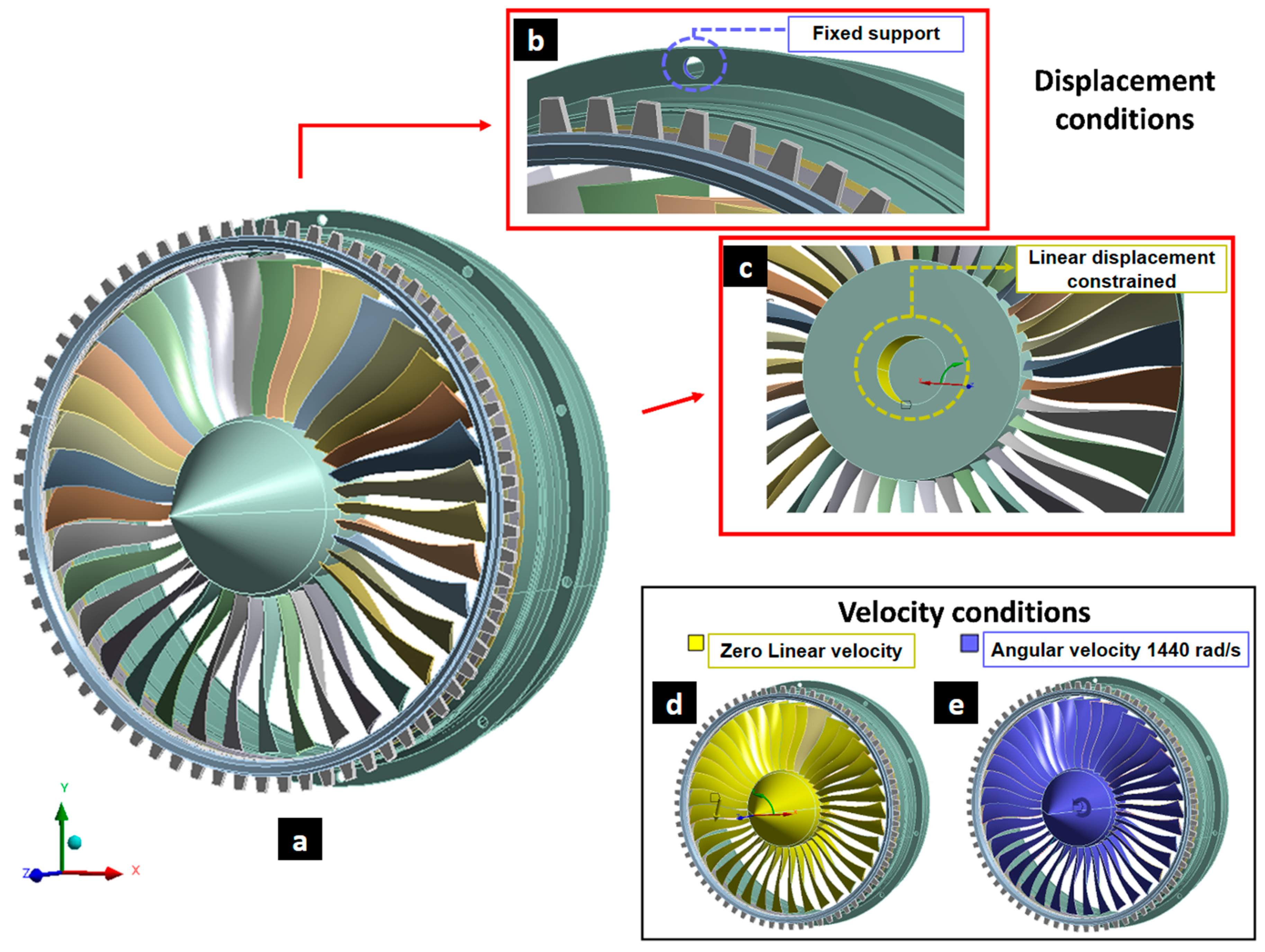
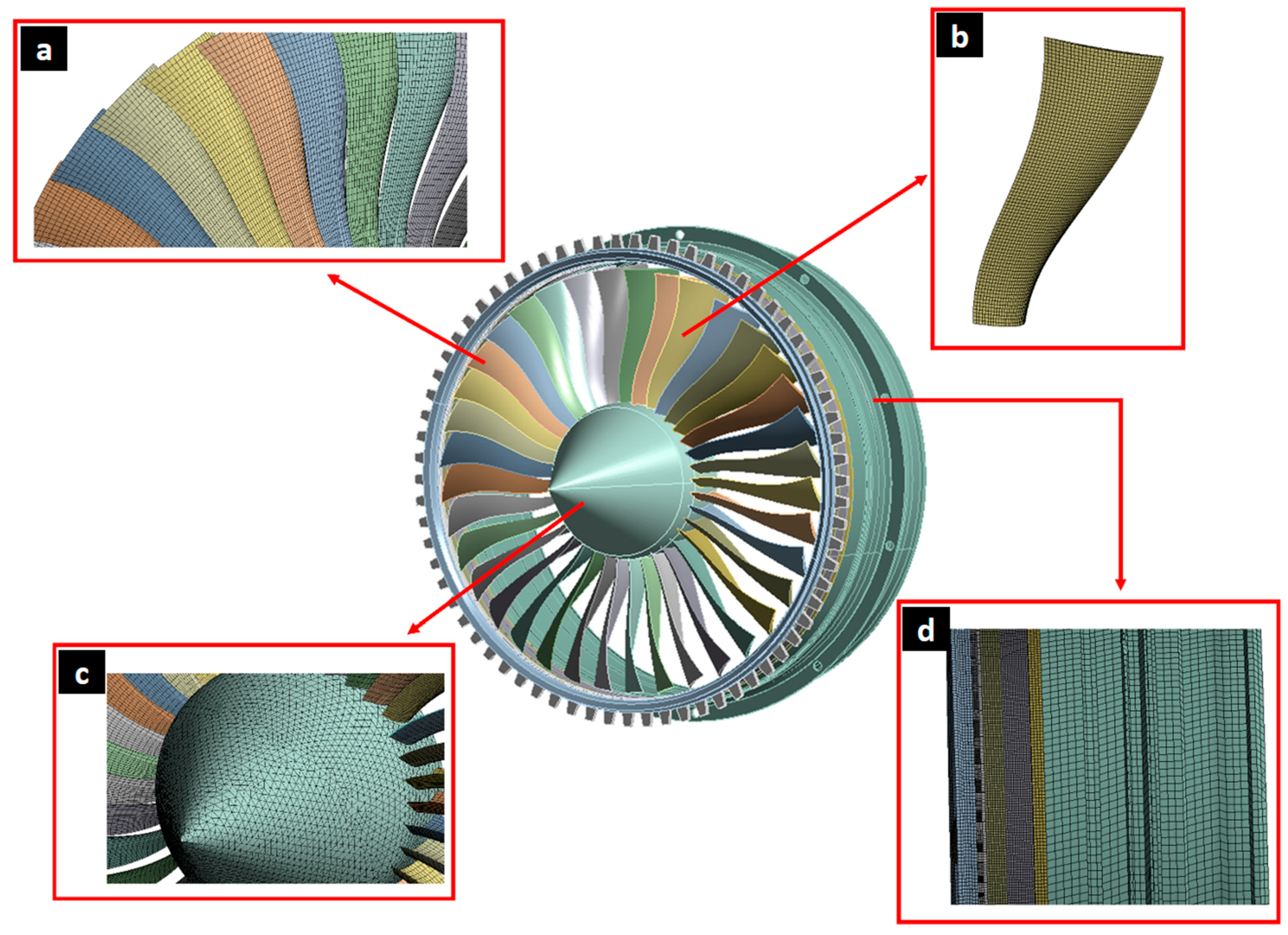
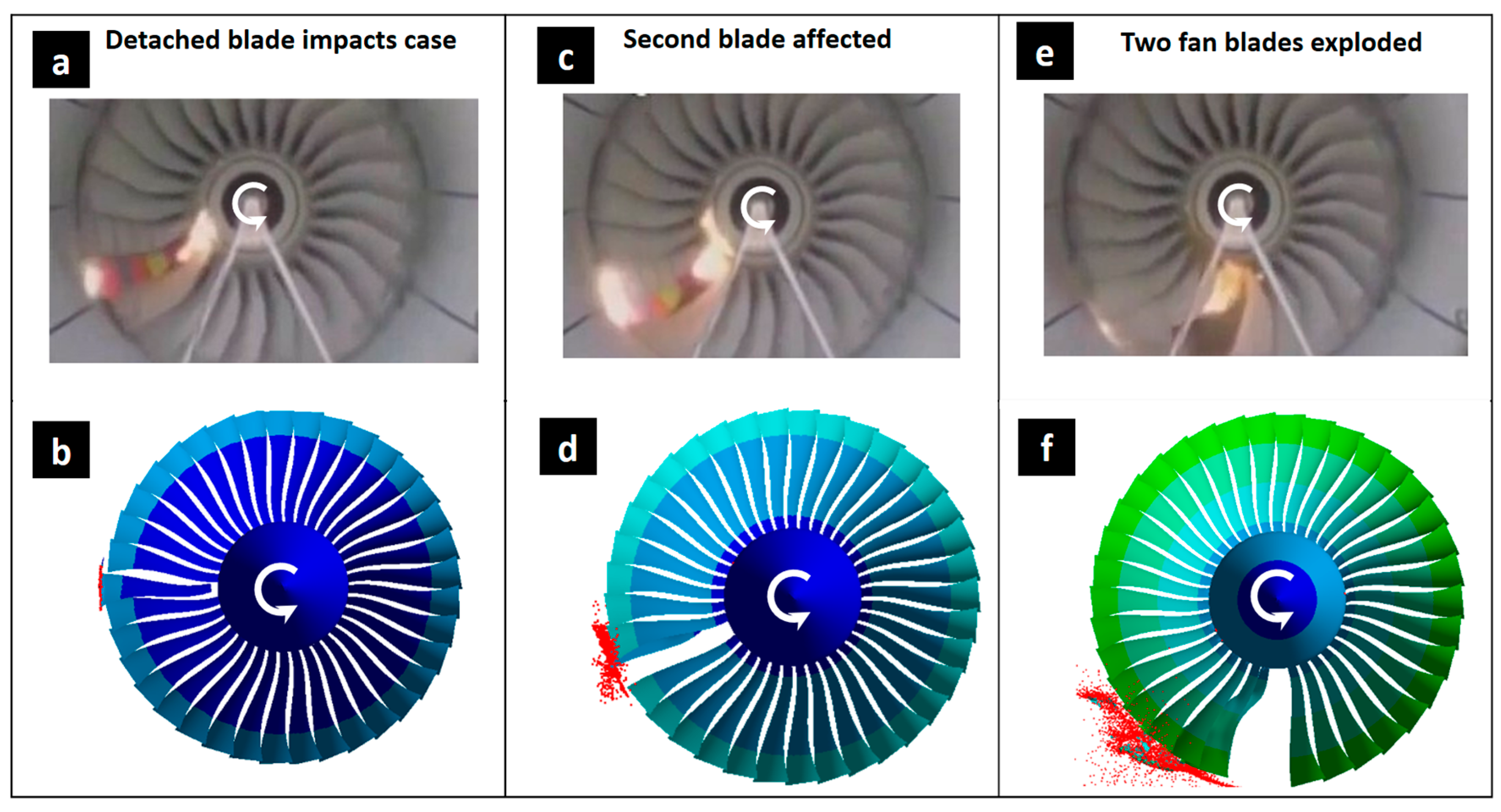
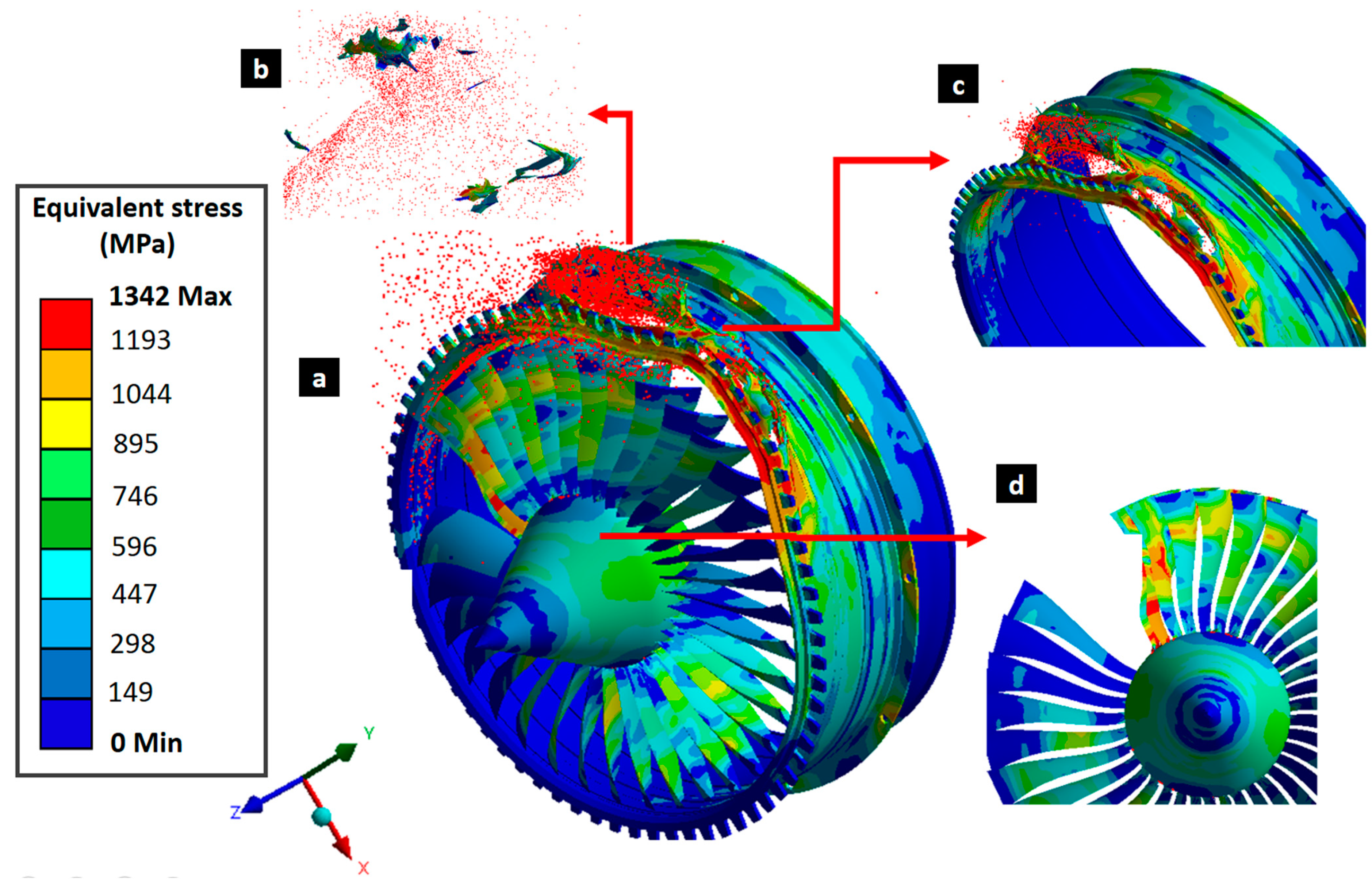
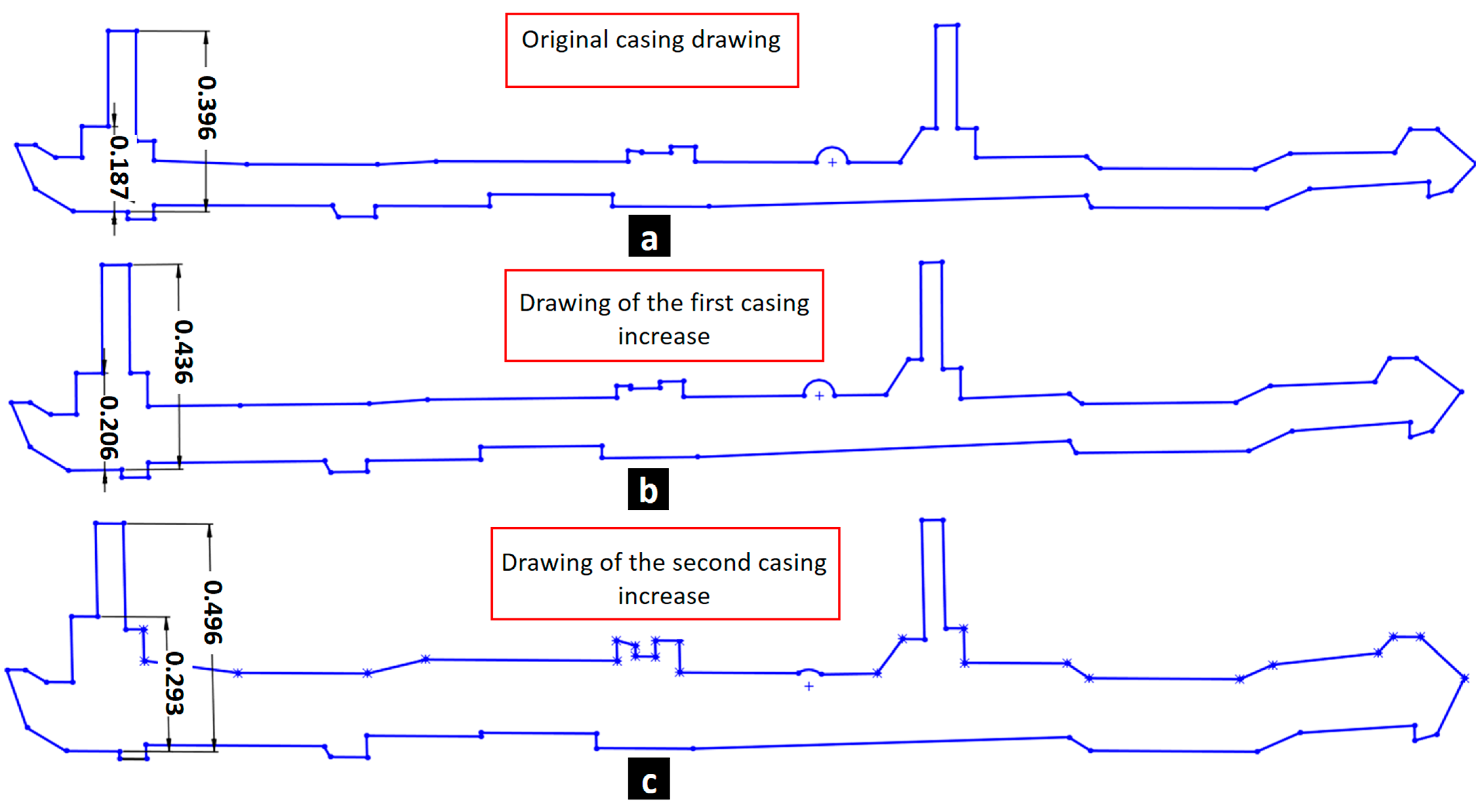
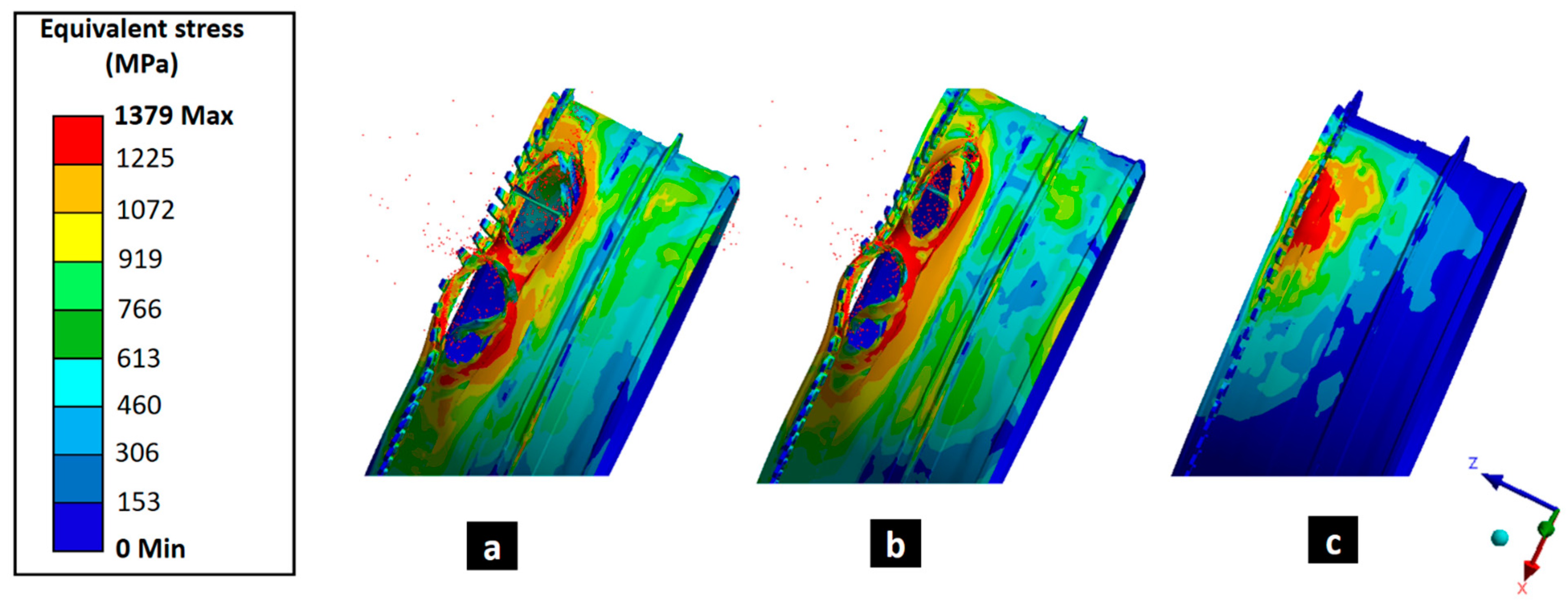

| Al | V | Fe | N | O | C | Ti |
|---|---|---|---|---|---|---|
| 6.1 | 4.0 | 0.3 | 0.05 | 0.2 | 0.08 | Bal. |
| Parameters | P. Verleysen and J. Peirs (2017) [43] | Tuninetti, Sepúlveda, Beecher et al. (2024) [35] | |
|---|---|---|---|
| Plasticity | A (MPa) | 895 | 927 |
| B (MPa) | 477 | 877.96 | |
| C | 0.011 | 0.0137 | |
| m | 0.86 | 0.594 | |
| n | 0.38 | 0.795 | |
| Damage | −0.078 | 0.246 | |
| 0.282 | 186.0 | ||
| 0.479 | −15.7 | ||
| 0.029 | 0.2582 | ||
| 3.87 | 1.2059 |
| Stress (MPa) | Plastic Strain (mm/mm) | Damage Parameter | |
|---|---|---|---|
| Blade | 1369 | 2.324 | 1 |
| Case | 1379 | 1.680 | 1 |
| Fan | 1351 | 0.946 | 0.6035 |
| Stress (MPa) | Plastic Strain (mm/mm) | Damage Parameter | ||||
|---|---|---|---|---|---|---|
| Tuninetti et al. 2024 [35] | Verleysen and Peirs 2017 [43] | Tuninetti et al. 2024 [35] | Verleysen and Peirs 2017 [43] | Tuninetti et al. 2024 [35] | Verleysen and Peirs 2017 [43] | |
| Blade | 1369 | 967 | 2.32 | 3.44 | 1 | 1 |
| Case | 1379 | 968 | 1.68 | 3.70 | 1 | 1 |
| Fan | 1351 | 962 | 0.95 | 0.37 | 0.603 | 1 |
| Stress (MPa) | Plastic Strain (mm/mm) | Damage Parameter | |||||||
|---|---|---|---|---|---|---|---|---|---|
| Initial Thickness | 1st Thickness Increase | 2nd Thickness Increase | Initial Thickness | 1st Thickness Increase | 2nd Thickness Increase | Initial Thickness | 1st Thickness Increase | 2nd Thickness Increase | |
| Blade | 1369 | 1358 | 1350 | 2.324 | 2.204 | 1.554 | 1 | 1 | 0.808 |
| Case | 1379 | 1375 | 1351 | 1.680 | 1.5 | 1.500 | 1 | 1 | 0.647 |
| Fan | 1351 | 1347 | 1342 | 0.946 | 1.467 | 0.570 | 0.604 | 1 | 0.418 |
Disclaimer/Publisher’s Note: The statements, opinions and data contained in all publications are solely those of the individual author(s) and contributor(s) and not of MDPI and/or the editor(s). MDPI and/or the editor(s) disclaim responsibility for any injury to people or property resulting from any ideas, methods, instructions or products referred to in the content. |
© 2024 by the authors. Licensee MDPI, Basel, Switzerland. This article is an open access article distributed under the terms and conditions of the Creative Commons Attribution (CC BY) license (https://creativecommons.org/licenses/by/4.0/).
Share and Cite
Tuninetti, V.; Sepúlveda, H. Computational Mechanics for Turbofan Engine Blade Containment Testing: Fan Case Design and Blade Impact Dynamics by Finite Element Simulations. Aerospace 2024, 11, 333. https://doi.org/10.3390/aerospace11050333
Tuninetti V, Sepúlveda H. Computational Mechanics for Turbofan Engine Blade Containment Testing: Fan Case Design and Blade Impact Dynamics by Finite Element Simulations. Aerospace. 2024; 11(5):333. https://doi.org/10.3390/aerospace11050333
Chicago/Turabian StyleTuninetti, Víctor, and Héctor Sepúlveda. 2024. "Computational Mechanics for Turbofan Engine Blade Containment Testing: Fan Case Design and Blade Impact Dynamics by Finite Element Simulations" Aerospace 11, no. 5: 333. https://doi.org/10.3390/aerospace11050333





